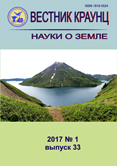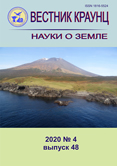Аннотация
Чагос-Лаккадивский хребет представляет собой линейно-вытянутую структуру, примыкающую к пассивной окраине западной Индии. Хребет состоит из трех сегментов: северного — Лаккадивский хребет, центрального — Мальдивский хребет и южного — банка (архипелаг) Чагос. Хребты разделены депрессиями и имеют различную выраженность в морфологии и аномальном гравитационном поле. Моделирование плотностной структуры тектоносферы Чагос-Лаккадивского хребта показало, что Лаккадивский и Мальдивский сегменты, по всей видимости, представляют собой погруженные блоки утоненной континентальной коры, частично отделенные от континентальной окраины Индии рифтогенным бассейном. Наряду с предположением, что банка Чагос может содержать фрагменты континентальной коры, главным фактором в ее формировании видимо является активная магматическая деятельность горячей точки Реюньон, приводящая к увеличению толщины коры за счет андерплейтинга. Физическое моделирование показало, что формирование такой линейной структуры возможно при наличии термических (горячая точка) и структурных (разломы и трещины) неоднородностей в модельной континентальной литосфере, что в пределах континентальной окраины приводило к перескоку (jumping) оси спрединга в сторону молодой окраины и частичному отделению от нее узких линейно-вытянутых микроблоков (хребтов).Библиографические ссылки
Булычев А.А., Зайцев А.Н. Свидетельство о государственной регистрации программы для ЭВМ № 2008611947 TG-2. Зарегистрировано в реестре пограмм для ЭВМ 18 апреля 2008 г. [Bulychev A.A., Zaitscev A.N. Svidetel'stvo o gosudarstvennoj registracii programmy dlya EVM № 2008611947 TG-2. Zaregistrirovano v reestre pogramm dlya EVM 18 aprelya 2008 g. (in Russian)].
Дубинин Е.П., Грохольский А.Л., Макушкина А.И. Физическое моделирование условий образования микроконтинентов и краевых плато континентальных окраин // Физика Земли. 2018. № 1. С. 69–82. https://doi.org/10.7868/S0002333718010064 [Dubinin E.P., Grokholsky A.L., Makushkina A.I. Physical Modeling of the Formation Conditions of Microcontinents and Continental Marginal Plateaus // Izvestiya, Physics of the Solid Earth, 2018, V. 54. № 1. P. 66–78. https://doi.org/10.1134/S1069351318010056].
Хаин В.Е. Тектоника континентов и океанов. М.: Научный мир. 2001. 606 с. [Hain V.E. Tectonics of continents and oceans. Moscow: Nauchnyy mir, 2001. 606 p. (in Russian)].
Шеменда А.И. Критерии подобия при механическом моделировании тектонических процессов // Геология и геофизика. 1983. № 10. С. 10–19 [Shemenda A.I. Criteria of similarity in physical modeling of geodynamic processes // Geology and Geophysics. 1983. № 10. P. 10–19 (in Russian)].
Шрейдер А.А. Геомагнитные исследования Индийского океана. М.: Наука. 2001. 319 с. [Schreider A.A. Geomagnetic studies of the Indian Ocean. M.: Nauka, 2001. 319 p. (in Russian)].
Ajay K.K., Chaubey A.K., Krishna K.S., Gopala Rao D., Sar D. Seaward dipping reflectors along the SW continental margin of India: Evidence for volcanic passive margin // Journal of Earth System Science. 2010. V. 119. № 6. P. 803–813.
Avraham Z.B., Bunce E.T. Geological study of the Chagos-Laccadive Ridge, Indian ocean // JGR. 1977. V. 82. Iss. 8. P. 1295–1305. https://doi.org/10.1029/JB082i008p01295.
Bhattacharya G.C., Yatheesh V. Plate-tectonic evolution of the deep ocean basins adjoining the western continental margin of India — a proposed model for the early opening scenario // Springer International Publishing Switzerland, 2015. S. Mukherjee (ed.), Petroleum Geosciences: Indian Contexts, Springer Geology. https://doi.org/10.1007/978-3-319-03119-4_1.
Chaubey A.K., Rao D.G., Srinivas K., Subrahmanyam V. et al. Analyses of multichannel seismic reflection, gravity and magnetic data along a regional profile across the central-western continental margin of India // Marine Geology. 2002. V. 182(3–4). P. 303–323.
Dietz R.S., Holden J.C. Reconstruction of Pangaea: Breakup and dispersion of continents, Permian to Present // JGR. 1970. V. 75. Iss. 26. P. 4939–4956.
Fisk M.R., Duncan R.A., Baxter A.N., Greenhough J.D., Hargraves R.B., Tatsumi Y. et al. Reunion hotspot magma chemistry over the past 65 Ma: Results from Leg 115 of the ocean drilling program // Geology. 1989. V. 17. P. 934–937.
Fontaine F.R., Barruol G., Tkalčić´ H. et al. Crustal and uppermost mantle structure variation beneath La Réunion hotspot track // Geophysical Journal International. 2015. V. 203(1). P. 107–126. https://doi.org/10.1093/gji/ggv279.
Francis T.J.G., Shor G.G. Seismic refraction measurements in the northwest Indian ocean // JGR. 1966. V. 71. Iss. 2. P. 427–449.
Grokholsky A.L., Dubinin E.P. Experimental modeling of structure-forming deformations in rift zones of mid-ocean ridges // Geotectonics. 2006. V. 40. № 1. P. 64–80.
Gupta S., Mishra S., Rai S.S. Magmatic underplating of crust beneath the Laccadive Island, NW Indian ocean // Geophysical Journal International. 2010. V. 183. Iss. 2. P. 536–542. https://doi.org/10.1111/j.1365-246X.2010.04759.x.
Kunnummal P., Anand S.P., Haritha C., Rama Rao P. Moho depth variations over the Maldive Ridge and adjoining Arabian & Central Indian basin, Western Indian Ocean, from three dimensional inversion of gravity anomalies // Journal of Asian Earth Sciences. 2017. V. 156. P. 316–330. https://doi.org/10. 1016/j.jseaes.2017.12.012.
Maus S., Barckhausen U., Berkenbosch H. et al. EMAG2: A 2–arc min resolution Earth Magnetic Anomaly Grid compiled from satellite, airborne, and marine magnetic measurements // Geochemistry Geophysics Geosystems. 2009. V.10. Iss. 8. 12 p. https://doi.org/10.1029/2009GC002471.
Misra A.A., Sinha N., Mukherjee S. Repeat ridge jumps and microcontinent separation: insights from NE Arabian Sea // Marine and Petroleum Geology. 2015. V. 59. P. 406–428. https://doi.org/10.1016/j.marpetgeo.2014.08.019.
Morgan W.J. Plate motions and deep mantle convection // Memoirs-Geological Society of America. 1972. V. 132. P. 7–22. https://doi.org/10.1130/MEM132-p7.
Muller R.D., Sdrolias M., Gaina C., Roest W.R. Age, spreading rates and spreading symmetry of the World’s ocean crust // Geochemistry, Geophysics, Geosystems. 2008. V. 9. № 4. 19 pp. https://doi.org/10.1029/2007GC001743.
Murty A.V.S., Arasu R.T., Dhanawat B.S., Subrahmanyam V.S.R. Some aspects of deep water exploration in the light of new evidences in the western Indian offshore / Hydrocarbon exploration (ed.) Bhatnagar A.K., 1999. Proceedings of the third international petroleum conference and exhibition (Petrotech-99). P. 457–463.
Naini B.R., Talwani M. Structural framework and the evolutionary history of the continental margin of western India // Studies in continental margin geology (eds) Watkins J.S. and Drake C.L., Am. Assoc. Pet. Geol. Mem. 1983. V. 3, 4. P. 167–191.
Sandwell D.T., Muller R.D., Smith W.H.F. et al. New global marine gravity model from CryoSat-2 and Jason-1 reveals buried tectonic structure // Science. 2014. V. 346. № 6205. P. 65–67. https://doi.org/10.1126/science.1258213.
Shemenda A.I., Grokholsky A.L. A formation and evolution of overlapping spreading centers (constrained on the basis of physical modeling) // Tectonophysics. 1991. V. 199. P. 389–404.
Shemenda A.I., Grocholsky A.L. Physical Modeling of Slow Seafloor Spreading // JGR. 1994. Solid Earth V. 99 (В5). P. 9137–9153.
Sreejith K.M., Unnikrishnan P., Radhakrishna M. Isostasy and crustal structure of the Chagos-Laccadive Ridge, Western Indian Ocean: Geodynamic implications // Journal of Earth System Science. 2019. V. 128(157). 13 p. https://doi.org/10.1007/s12040-019-1161-2.
Todal A., Eldholm O. Continental margin off western India and Deccan large igneous province // Marine Geophysical Research. 1998. V. 20. P. 273–291.
Torsvik T.H., Amundsen H., Hartz E.H. et al. Precambrian microcontinent in the Indian ocean // Nature Geoscience. 2013. № 6. P. 1–5.
Weatherall P., Marks K.M., Jakobsson M., Schmitt T., Tani S., Arndt J.E., Rovere M., Chayes D., Ferrini V., Wigley R. A new digital bathymetric model of the world’s oceans // Earth and Space Science. 2015. V. 21. № 2. P. 331–345. https://doi.org/10.1002/2015EA000107.
Weatherall P., Marks K. M., Jakobsson M. et al. A new digital bathymetric model of the world’s oceans // Earth and Space Science. 2015. V. 21. № 2. P. 331–345. https://doi.org/10.1002/2015EA000107
Whittaker J.M., Halpin J.A., Williams S.E. et al. Tectonic evolution and continental fragmentation of the Southern West Australian margin // West Australian Basins Symposium. Perth. WA. 2013. 18 p.

Контент доступен под лицензией Creative Commons Attribution-NonCommercial 4.0 International License.

